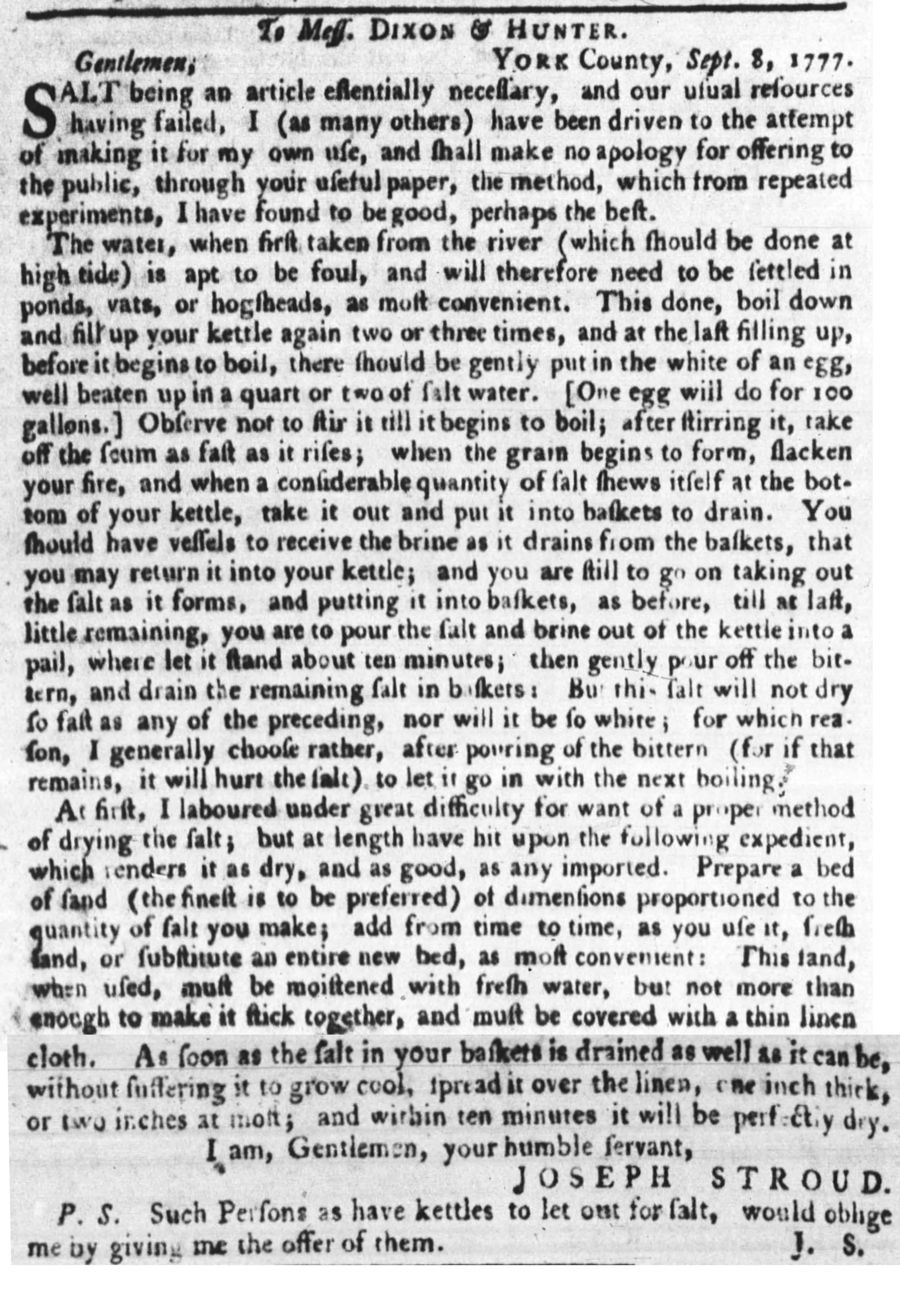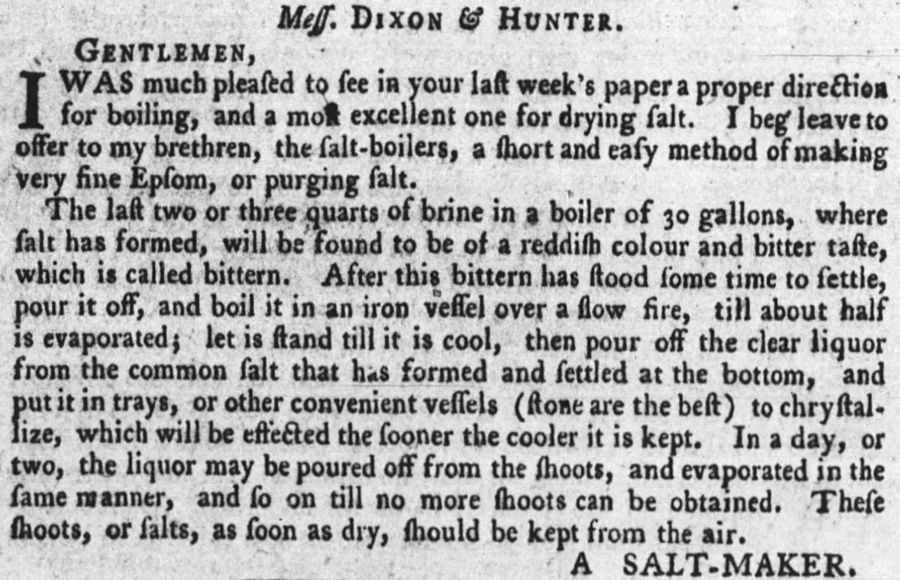
At the outset of the Revolutionary War, one of the necessities that was in short supply was salt. Those along the seacoast, or near the mouths of rivers that flowed into the sea, found that they could help meet this need by boiling sea water. In 1777, Joseph Stroud wrote a letter to The Virginia Gazette, describing how to go about doing this. The letter, published on Friday, 12 Sep 1777, is transcribed below.
Mess. Dixon & Hunter.
York County, Sept. 8, 1777.
Gentlemen,
Salt being an article essentially necessary, and our usual resources having failed, I (as many others) have been driven to the attempt of making it for my own use, and shall make no apology for offering to the public, through your useful paper, the method, which from repeated experiments, I have found to be good, perhaps the best.
The water, when first taken from the river (which should be down at high tide) is apt to be foul, and will therefore need to be settled in ponds, vats, or hogsheads, as most convenient. This done, boil down and fill up your kettle again tow or three times, and at the last filling up, before it begins to boil, there should be gently put in the white of an egg, well beaten up in a quart of two of salt water. [One egg will do for 100 gallons.] Observe not to stir it till it begins to boil; after stirring it, take off the scum as fast as it rises; when the grain begins to form, slaken your fire, and when a considerable quantity of salt shews itself at the bottom of your kettle, take it out and put it into baskets to drain. You should have vessels to receive the brine as it drains from the baskets, that you may return it into your kettle; and you are still to go on taking out the salt as it forms, and putting it into baskets, as before, till at last, little remaining, you are to pour the salt and brine out of the kettle into a pail, where let it stand about ten minutes; then gently pour off the bittern, and drain the remaining salt in baskets: But this salt will not dry so fast as any of the preceding, nor will it be so white; for which reason, I generally choose rather, after pouring of the bittern (for if that remains, it will hurt the salt) to let it go in with the next boiling.
At first, I laboured under great difficulty for want of a proper method of drying the salt; but at length have hit upon the following expedient, which renders it as dry, and as good, as any imported. Prepare a bed of sand (the finest is to be preferred) of dimensions proportioned to the quantity of salt ou make; add from time to time, as you use it, fresh sand, or substitute an entire new bed as most convenient: This sand, when used, must be moistened with fresh water, but not more than enough to make it stick together, and must be covered with a thin linen cloth. As soon as the salt in your baskets is drained as well as it can be, without suffering it to grow cool, spread it over the linen, on inch thick, or two inches at most; and within ten minutes it will be perfectly dry.
I am, Gentlemen, your humble servant,
Joseph Stroud.
P.S. Such Persons as have kettles to let out for salt, would oblige me by giving me the offer of them.
The next week (19 Sep 1777) a writer calling himself "A Salt-Maker," made some additional comments which are transcribed below.
Mess. Dixon & Hunter.
Gentlemen,
I was much pleased to see in your last week's paper a proper direction for boiling, and a most excellent one for drying salt. I beg leave to offer to my brethren, the salt-boilers, a short and easy method of making very fine Epsom, or purging salt.
The last two or three quarts of brine in a boiler of 30 gallons, where salt has formed, will be found to be of a reddish colour and bitter taste, which is called bittern. After this bittern has stood some time to settle, pour it off, and boil it in an iron vessel over a slow fire, till about half is evaporated; let it stand till it is cool, then pour off the clear liquor from the common salt that has formed and settled at the bottom, and put it in trays, or other convenient vessels (stone are the best) to crystallize, which will be effected the sooner the cooler it is kept. In a day, or two, the liquor may be poured off from the shoots, and evaporated in the same manner, and so on till no more shoots can be obtained. These shoots, or salts, as soon as dry, should be kept from the air.
A Salt-Maker
The processes described here are likely to have been very similar to those used at the salt wells in early Bullitt County history.
Images of these letters are shown here. Note that the letter "s" was usually written to look like an "f."


If you, the reader, have an interest in any particular part of our county history, and wish to contribute to this effort, use the form on our Contact Us page to send us your comments about this, or any Bullitt County History page. We welcome your comments and suggestions. If you feel that we have misspoken at any point, please feel free to point this out to us.
The Bullitt County History Museum, a service of the Bullitt County Genealogical Society, is located in the county courthouse at 300 South Buckman Street (Highway 61) in Shepherdsville, Kentucky. The museum, along with its research room, is open 10 a.m. to 4 p.m. Monday through Friday. Saturday appointments are available by calling 502-921-0161 during our regular weekday hours. Admission is free. The museum, as part of the Bullitt County Genealogical Society, is a 501(c)3 tax exempt organization and is classified as a 509(a)2 public charity. Contributions and bequests are deductible under section 2055, 2106, or 2522 of the Internal Revenue Code. Page last modified: 12 Sep 2024 . Page URL: bullittcountyhistory.org/bchistory/salt2.html